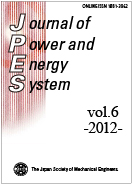Volume 6, Issue 3
Displaying 1-10 of 10 articles from this issue
- |<
- <
- 1
- >
- >|
Papers
-
2012Volume 6Issue 3 Pages 353-359
Published: 2012
Released on J-STAGE: August 03, 2012
Download PDF (333K) -
2012Volume 6Issue 3 Pages 360-377
Published: 2012
Released on J-STAGE: August 03, 2012
Download PDF (958K) -
2012Volume 6Issue 3 Pages 378-393
Published: 2012
Released on J-STAGE: August 10, 2012
Download PDF (425K) -
2012Volume 6Issue 3 Pages 394-401
Published: 2012
Released on J-STAGE: August 23, 2012
Download PDF (409K) -
2012Volume 6Issue 3 Pages 402-411
Published: 2012
Released on J-STAGE: August 23, 2012
Download PDF (1079K) -
2012Volume 6Issue 3 Pages 412-422
Published: 2012
Released on J-STAGE: October 16, 2012
Download PDF (771K) -
2012Volume 6Issue 3 Pages 423-434
Published: 2012
Released on J-STAGE: November 06, 2012
Download PDF (2771K) -
2012Volume 6Issue 3 Pages 435-445
Published: 2012
Released on J-STAGE: November 20, 2012
Download PDF (689K) -
2012Volume 6Issue 3 Pages 446-461
Published: 2012
Released on J-STAGE: December 07, 2012
Download PDF (697K) -
2012Volume 6Issue 3 Pages 462-471
Published: 2012
Released on J-STAGE: December 21, 2012
Download PDF (390K)
- |<
- <
- 1
- >
- >|
